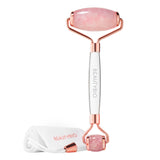THIS ARTICLE REFERENCES THESE PRODUCTS
If you’re a child of any decade prior to mass info dissemination via the internet, the way you discovered and educated yourself about skincare was to get dressed, go to a mall, sit down at a cosmetic counter and have an in-person (shocking, right?) consultation about your skin. The specialist would load you up with a cleanser, hydrator and toner (hello, Clinique) without so much as a nod to preventative care for areas like the eyes. But 15 years and 3 jobs later, the visible droopage, crow's feet and fine lines cropping up made us wish we had a serum, or 4, to correct and prevent future damage. Here's what I wish I knew about the eyes and eyelid tightening 20 years ago and why they rightfully have their own skincare category.
Why the eye?
The eye area arguably endures more than skin anywhere else on the body; it’s the first to betray signs of age, stress and fatigue. Knowing how to tighten eyelids at home is essential.
Is it really that different from the rest of my facial/body skin?
Smiling, squinting and blinking add up to 10K eye movements per day, and the under-eye skin is 10x thinner than the rest of our facial skin. The eye area is also lacking in soft tissue, like fat and muscle, so the skin is more likely to have a saggy, hollowed appearance. The cherry on top? We don’t have oil glands surrounding the eye area, so it’s especially difficult to produce and retain moisture in that region. To say our eyes are constantly fighting an uphill battle to recover from thousands of daily repetitive movements (not to mention sun, pollution and debris exposure) is an understatement.
Why do eyelids sag?
Eyelids naturally sag over time with age, stress and the natural pull of gravity. The medical term for drooping, saggy eyelids is “ptosis” – the term covers anything from a little droopage to a lot of extra baggage. In some severe cases of ptosis, the person’s eyesight is hindered, and surgery may be required to regain unencumbered sight, but usually you can learn how to tighten eyelid skin without surgery. Most cases of ptosis occur from a weakening of the muscles responsible for lifting the eyelid, these are called levators. And those sleepless nights don’t help; we put strain on the muscles keeping our peepers open after a night, or several, of inadequate sleep.
Eyelids can also get puffier over time
Aside from the gravitational sag, eyelids can adopt permanent puffiness once the tissues in the lids weaken causing fat deposits to slide down and rest on the lower part of the eyelid. These fatty deposits show up as puffy looking eyes and can be exacerbated by edema (fluid retention), which can be improved with regular
lymphatic drainage.
What ingredients should I look for to tighten and firm the eyelids?
In terms of eye lift products to tighten eyelids at home, the answer is anything that checks the boxes on
hydration,
brightening,
de-puffing (aka firming), lifting and antioxidant protection. Your hard hitters in these categories are going to be Vitamins C (brightening), E (protecting) and A (tone, texture and wrinkles) and sodium hyaluronate/hyaluronic acid (hydration).
And tap into the preventative power of plants
Persian Silk Tree Bark is a popular but often unmentioned ingredient for lifting, upper eyelid tightening, and protection because it works to prevent glycation, which is the aging and subsequent inelasticity Persian Silk Tree Bark strengthens and protects existing skin proteins to elongate the lifecycle of your collagen and elastin, keeping eyes looking lifted and firm.
SHOP THE STORY
Sources:
https://www.allaboutvision.com/conditions/droopinglids.htm
https://www.aao.org/eye-health/diseases/what-is-ptosis
https://www.healthline.com/health/eye-health/how-to-get-rid-of-puffy-eyes#causes
https://www.elle.com/beauty/makeup-skin-care/tips/a2447/skin-care-best-eye-cream-ingredients-383992/
https://www.mzskin.com/news/albizia-julibrissin-bark-extract/?v=7516fd43adaa










